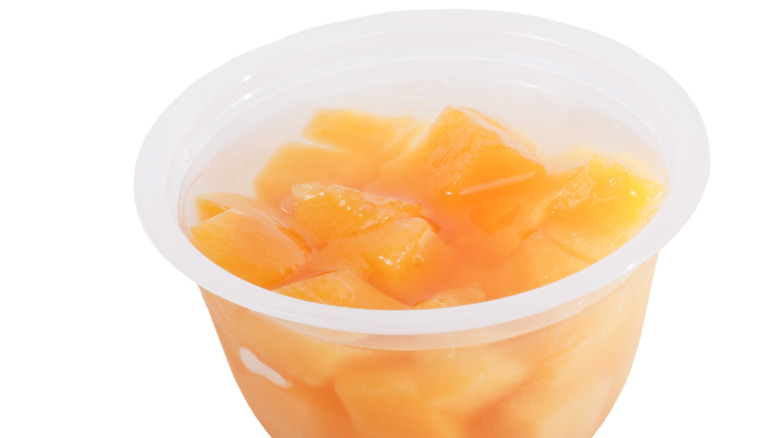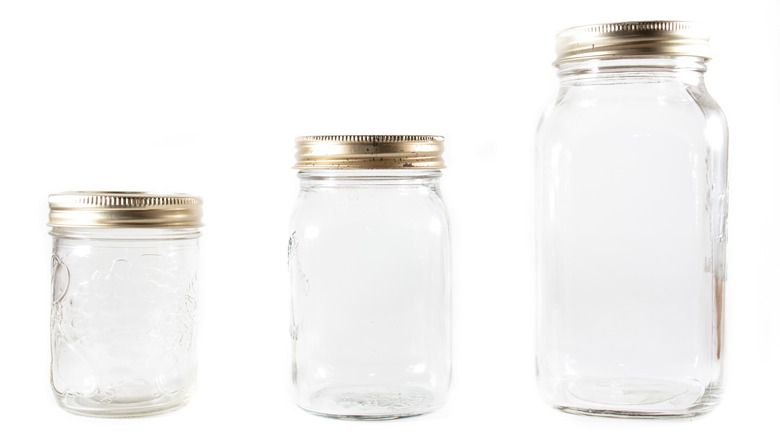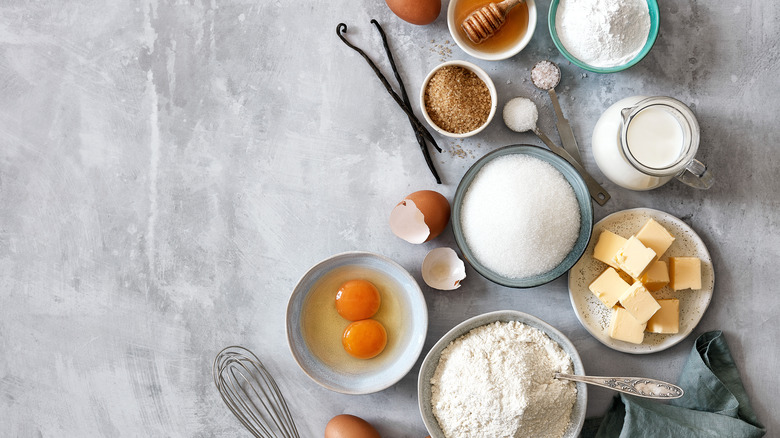The Plastic Fruit Cup Hack That Makes Meal-Prepping More Convenient
After finishing the last bites of a cup of mandarin oranges or peaches, you probably put the plastic container in the recycling bin and move on with the day. But what if we told you that you're missing out on a surprisingly simple meal prep hack? You can hold on to and repurpose your fruit cups to store chips, pretzels, crackers, popcorn, and so much more.
The opening at the top of your plastic container is roughly the same width as the opening of a wide-mouth mason jar, which means the two can fit flush together and create not one but two chambers to hold ingredients. To do so, refill the plastic cup with a handful of granola or another crunchy ingredient of your choice. Then, place a wide-mouth metal lid over the plastic cup to act as a divider between the glass and the plastic. You'll want to have the metal side facing down, and the white interior of the lid facing up toward you. Pinch the metal lid and the plastic cup together and flip the whole thing upside down to fit over your wide-mouth mason jar.
@therealjustcrumbs If you like having fruit cups as a snack, save the empty plastic cup to use for this cool kitchen hack! #fruitcup #masonjar #snacks #unprocessyourfood #kitchenhack #nowaste #lowwaste #tipsandtricks #easyrecipe #eathealthy #nutritious
Use a metal ring to twist them tight and seal the whole contraption together. Now, you have a mason jar hack to make a snack cup, similar to those you've seen at the grocery store, to pair pretzel chips or granola with hummus or yogurt. The lid will keep the liquids in place and protect dry ingredients from moisture.
Make your grab-and-go container even better
This hack is clever on its own, but there are many ways to tweak it to even better fit your needs. Consider picking up containers in different sizes — paying attention to ensure you're buying wide-mouth, not regular, jars — to hold different food servings. A 4-ounce wide-mouth mason jar might be the perfect vessel for chips and guacamole or matcha overnight oats and coconut flakes, whereas a 32-ounce is a better for soup and croutons for two.
For snackers preparing multiple ingredients in one wide-mouth mason jar, there is another technique that can provide a third chamber for all your meal components. Take two fruit cups and fill them with their respective foods. Fit the lid over one cup and place it upside down over the other to create a plastic cup "sandwich" with the metal lid in the middle. Then, place the whole thing into the wide-mouth mason jar.
Use the glass to hold larger damp or dry snacks like sliced cheeses or apples, the center cup for sticky items like nut butter or olives, and the top cup for crackers or toothpicks. This approach is helpful for sandwiches and tacos, as you can devote the chambers to meat or veggies; mayo or salsa; and limes, herbs, or your starchy component. You can technically fill the glass halfway with wet stuff, too, but it may get the bottom of your fruit cup a little messy, so pack a paper towel.
Use a fruit cup when meal prepping liquids
You can also take advantage of the plastic fruit cup hack to store liquid ingredients. Instead of inverting a fruit cup over the glass, you can nest a liquid-filled plastic cup face up over top of dry ingredients. This is especially helpful for bakers prepping a small serving of pancake, waffle, or muffin mix the day before, as you can keep the beaten egg and milk separate from the dry ingredients until you're ready to activate the leavening agent.
This container tip helps with a key part of component cooking meal prep, too. Sauces and vinaigrettes transform basic pre-made ingredients, like lentils or salmon, into a variety of meals, staving off tastebud fatigue from repeated lunches. Load multiple wide-mouth mason jars with grains and proteins, then fill one fruit cup with barbecue sauce, another with tzatziki, and a third with pesto for three unique meals. By keeping the dressings separate, you'll gain the flexibility to change up the flavors and to freeze unused ingredients without worrying about future watery thawed sauces.
Finally, you can keep savory and sweet components (and their odors) separate. If you prefer a hard boiled egg and a fruit salad for breakfast but don't want to eat them together, place the prepped items in two different chambers. You can arrange the egg-filled fruit cup over top or nestled in the jar, but we suggest adding cellophane over the plastic to get extra protection against moisture from the egg.



